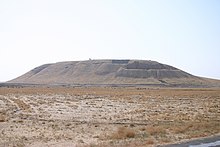
Back Tell Afrikaans تل (علم الآثار) Arabic تل (اثار) ARZ Tell (arxeologiya) Azerbaijani Тел (хълм) Bulgarian Tel Catalan Tell Czech Byhøj Danish Tell (Archäologie) German Τελλ Greek


In archaeology a tell (borrowed into English from Arabic: تَلّ, tall, "mound" or "small hill")[1] is an artificial topographical feature, a mound[a] consisting of the accumulated and stratified debris of a succession of consecutive settlements at the same site, the refuse of generations of people who built and inhabited them and natural sediment.[2][3][4][b][c]
Tells are most commonly associated with the ancient Near East but are also found elsewhere, such as in Southern and parts of Central Europe, from Greece and Bulgaria to Hungary and Spain,[5][6] and in North Africa.[2][7][8][9] Within the Near East they are concentrated in less arid regions, including Upper Mesopotamia, the Southern Levant, Anatolia and Iran, which had more continuous settlement.[10] Eurasian tells date to the Neolithic,[11] the Chalcolithic and the Bronze and Iron Ages.[12] In the Southern Levant the time of the tells ended with the conquest by Alexander the Great, which ushered in the Hellenistic period with its own, different settlement-building patterns.[citation needed] Many tells across the Near East continue to be occupied and used today.[13]
- ^ Kirkpatrick 1983, p. 1330.
- ^ a b Shaw 2002, p. 566.
- ^ Negev & Gibson 2001, p. 497.
- ^ Matthews 2014.
- ^ Bailey&al 1998, pp. 373–396.
- ^ Blanco-González & Kienlin 2020, see map.
- ^ MacDonald 1997, pp. 40–42.
- ^ Davidson&al 2010, pp. 1564–1571.
- ^ Kotsakis 1999, p. 66.
- ^ Wilkinson 2003, pp. 100–127.
- ^ Blanco-González & Kienlin 2020.
- ^ Chapman 2020.
- ^ ASOR 2019.
Cite error: There are <ref group=lower-alpha> tags or {{efn}} templates on this page, but the references will not show without a {{reflist|group=lower-alpha}} template or {{notelist}} template (see the help page).
© MMXXIII Rich X Search. We shall prevail. All rights reserved. Rich X Search